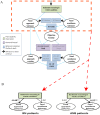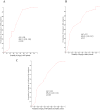Improved planning abilities in binge eating
- PMID: 25148580
- PMCID: PMC4141805
- DOI: 10.1371/journal.pone.0105657
Improved planning abilities in binge eating
Abstract
Objective: The role of planning in binge eating episodes is unknown. We investigated the characteristics of planning associated with food cues in binging patients. We studied planning based on backward reasoning, reasoning that determines a sequence of actions back to front from the final outcome.
Method: A cross-sectional study was conducted with 20 healthy participants, 20 bulimia nervosa (BN), 22 restrictive (ANR) and 23 binging anorexia nervosa (ANB), without any concomitant impulsive disorder. In neutral/relaxing, binge food and stressful conditions, backward reasoning was assessed with the Race game, promotion of delayed large rewards with an intertemporal discounting task, attention with the Simon task, and repeating a dominant behavior with the Go/No-go task.
Results: BN and to a lower extent ANB patients succeeded more at the Race game in food than in neutral condition. This difference discriminated binging from non-binging participants. Backward reasoning in the food condition was associated with lower approach behavior toward food in BN patients, and higher food avoidance in ANB patients. Enhanced backward reasoning in the food condition related to preferences for delayed large rewards in BN patients. In BN and ANB patients the enhanced success rate at the Race game in the food condition was associated with higher attention paid to binge food.
Conclusion: These findings introduce a novel process underlying binges: planning based on backward reasoning is associated with binges. It likely aims to reduce craving for binge foods and extend binge refractory period in BN patients, and avoid binging in ANB patients. Shifts between these goals might explain shifts between eating disorder subtypes.
Conflict of interest statement
Figures



References
-
- Fairburn CG, Harrison PJ (2003) Eating disorders. Lancet 361: 407–416. - PubMed
-
- Hadigan CM, Kissileff HR, Walsh BT (1989) Patterns of food selection during meals in women with bulimia. Am J Clin Nutr 50: 759–766. - PubMed
-
- Fairburn CG, Wilson GT, (1993) editors Binge eating: nature, assessment and treatment: Guilford Press.
-
- Gaudreau P, Carraro N, Miranda D (2011) From goal motivation to goal progress: the mediating role of coping in the Self-Concordance Model. Anxiety Stress Coping - PubMed
-
- Brooks S, Prince A, Stahl D, Campbell IC, Treasure J (2011) A systematic review and meta-analysis of cognitive bias to food stimuli in people with disordered eating behaviour. Clin Psychol Rev 31: 37–51. - PubMed
Publication types
MeSH terms
LinkOut - more resources
Full Text Sources
Other Literature Sources

